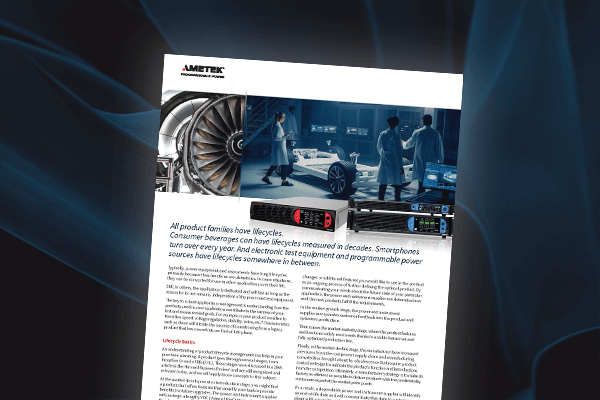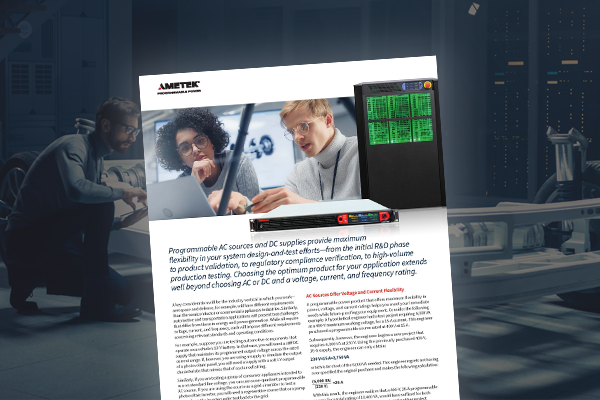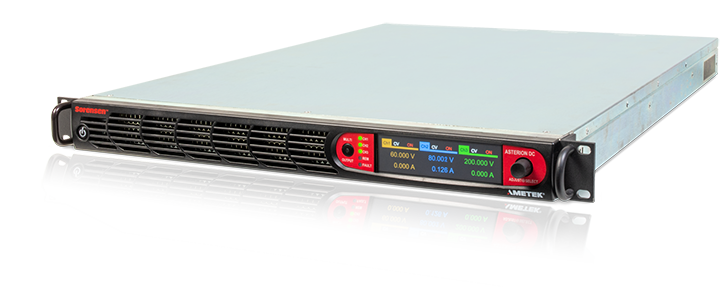Navigate the Shift to Modern Power Supplies With Confidence
Navigate the Shift to Modern Power Supplies With Confidence
Understand Product Lifecycles to Ensure a Smooth End-of-Life Transition
Power equipment and instruments have long life cycles primarily because their functions are ubiquitous. The key to robust application management is understanding how the products used in your application contribute to the success of your test and measurement goals. In this white paper, learn about a product’s lifecycle, how that lifecycle can affect any end-of-life (EOL) transitions you receive from a supplier and how you manage those transitions effectively and efficiently.
Preparation Time Eases EOL Transition While Ushering in New Product Lines
As technology evolves, inevitably, innovation will impact the product life cycle. With enough time and planning, the transition should not cause undue stress. The team at Fuseco can make this possible.
Top Considerations When Choosing Modern AC Sources and DC Power Supplies
Choosing the optimum programmable AC source or DC supply for your application extends well beyond choosing AC or DC and a voltage, current, and frequency rating. Your industry and so much more factor into the evolving needs for upgrading, and challenges abound in finding a suitable match to see you in the future. As new technologies are always on the horizon, how can a customer have a forward-thinking mindset while buying power supplies? Find out more in this white paper.
Programmable AC Sources Add Features to Expand Purchasing Options
Programmable AC sources are evolving as their performance increases, and they add features. If you are in the market for an AC source for the first time in five or ten years, you will notice some significant differences.
Purchasing Criteria for Programmable DC Supplies Evolve as Performance and Features Advance
If you are in the market for a programmable DC power supply for the first time in five or ten years, you will notice some significant improvements. Modern supplies offer higher power densities, helping you save rack space. In addition, modern supplies can provide considerable flexibility in power, current, and voltage ratings, helping you future-proof your test systems to meet changing requirements.
Why Fuseco?
Fuseco stands to help you with all your AMETEK Programmable Power needs. We are ready to assist customers with managing product transitions, finding the best fit for new power sources and supplies, and more. Don't hesitate to reach out to our experts for more information!
We're here to help
Talk to an expert today.
Our friendly team of highly trained specialists will quickly assist you.
We promise to respond within 4 business hours (AEST).
Or you will receive $100 off your next purchase. Read how it works.
Top FAQs
When purchasing a power supply, the first choice to be made is linear supply or switching supply. Linear power supplies offer low ripple and noise specifications and have fast transient behavior. However they are inefficient and generate a lot of heat. They are also quite heavy. As a result most engineers prefer linear power supplies for low power applications. Using switching power supplies is a better choice for higher output power or multichannel applications. They provide higher power density. Switching power supplies are easier to control than linear supplies and cost about the same per channel.
Transient response is a measure of how well a power supply copes with changes in current demand or how well the supply follows the changes in the load impedance. This is an important specification for many applications.
DC output voltage slew rate is a rise or fall time. DC programmable power supplies have output filters that use large capacitors that store a lot of energy. It’s mainly the charge and discharge time of this filter, combined with the current demand of the DUT, which determine a supply’s voltage slew rate. The voltage slew rate is mostly independent of the connected EUT.
Load Regulation is an important specification of programmable power supplies. This means some percent output voltage change from its set-point due to a change in the current demand of the EUT. Normally this effect should be very small, less than 0.01% of set output voltage.
Line regulation specifies the percent change of the DC output voltage or current as a function of AC input line voltage. This specification is important when the input line voltage is not stable.
Stability is a measure of a supply’s long term output voltage or current drift. Stability is primarily specified in parts per million or ppm.
If more output current is required then paralleling power supply outputs is generally the solution. Ametek Programmable Power uses a dedicated control bus to connect its power supplies in parallel. The system configures itself automatically, identifying which unit is the master and which units are the slaves.
If more output voltage is required then connecting power supplies outputs in series is generally the solution. All you have to do is to connect the positive terminal of one supply to the negative of another. The limitation is that when operated in series, there are no master and slave units. Individual power supplies has to be programmed.
DC programmable power supplies typically provide a standard and isolated analog interface. Through the analog interface a supply’s DC output voltage, current and over voltage protection can be set. The control signal can be a voltage signal, a current signal or by connecting a resistor to the analog input.
Many DC programmable power supplies can be configured for either local or remote sensing. For a more accurate output voltage setting, remote sensing should be use. This method compensates for the voltage drop across the leads to the load terminals.

Upgrading to the Asterion power supply system has given us significant more testing capability and flexibility. It has been a wise investment. Thank you for your advice and support.
Margaret Smith
TEST LABORATORY SENIOR ANALYST AT UNIVERSITY OF NSW

Buying the MX45 California Instruments power source has given us enhanced testing capabilities. We have the SNK option, which is a bidirectional sink option. We are now able to simulate all grid conditions in our lab environment up to 45kVA. For me, reliability is important and I’m happy to say that we have been using this device for many years without any issues.
Keith Boydell
RESEARCH FELLOW AT UNIVERSITY OF WOLLONGONG

We have several Sorensen power supplies in our lab and they are the lowest output noise power supply we have experienced. For any critical research project where output noise and line/load regulations are important, we use only Sorensen power supplies.
Annette Eskdale
TEST LABORATORY MANAGER AT MONASH UNIVERSITY
Technical Support
Our experts are all pre-eminent leaders in electrical products who provide excellent support in their areas of expertise.
Technical supportTalk to an expert
Our friendly team are highly trained product experts who really enjoy helping customers find what they need.
call 1300 387 326Enquire by email
We promise to respond within 4 business hours (AEST) or you will receive $100 off your next purchase.
Enquire now




